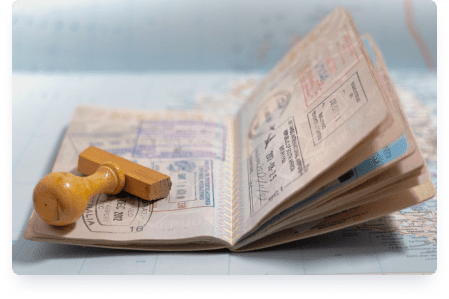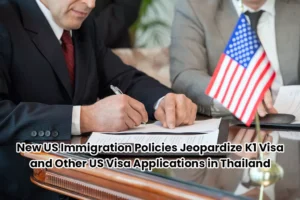In recent years, the acceptance and recognition of same-sex relationships have grown exponentially on a global scale. For Thai-U.S. couples, this progress has opened doors to new possibilities, including the opportunity for them to live together in the United States. The K-1 visa, commonly known as the fiancé(e) visa, is a critical tool for many Thai nationals in same-sex relationships with their American partners.
This article aims to guide you through the K-1 visa process, highlighting key steps and offering practical advice to complete this journey smoothly.
What is a K-1 Visa?
The K-1 visa, often referred to as the Fiancé(e) Visa, is specifically designed for the foreign fiancé(e) of a United States citizen. This special category of visa falls under the non-immigrant class, yet promises a bright future in the U.S. for international couples. It’s a unique pathway that allows the Thai partner to enter the United States with the intent of marrying their American partner within a 90-day window. This short period is meant to culminate in a wedding, a celebration of their union in the U.S.
Once the couple is married, this visa paves the way for the next big step in their journey together. The Thai spouse, now married to an American citizen, can apply for an adjustment of status. This is a significant transition from non-immigrant to permanent residency status, turning the foreigner into a Green Card holder. Holding a Green Card opens up new horizons for the Thai spouse, allowing them to live, work, and build a life in the United States alongside their partner. The K-1 visa thus not only unites partners but also lays the foundation for potential retirement in the U.S.
Eligibility Criteria
For same-sex couples seeking a K-1 visa, where one partner is Thai and the other a U.S. citizen, certain key requirements must be met:
- Both partners need to be legally free to marry, meaning any previous marriages must have been formally ended.
- The couple must have met in person at least once in the two years before applying.
- The U.S. citizen must also meet specific income requirements to sponsor their Thai fiancé(e). This involves providing proof of income to ensure the couple can support themselves without government assistance.
Meeting these requirements is crucial to demonstrating the relationship’s legitimacy and the couple’s readiness to build a life together.
Application Process
- Filing the Petition: The process begins with the U.S. citizen partner filing Form I-129F, Petition for Alien Fiancé(e), with U.S. Citizenship and Immigration Services (USCIS). This form establishes the relationship’s validity.
- Notice of Action: After filing, USCIS sends a Notice of Action, confirming receipt of the petition.
- Petition Approval: Once approved, USCIS forwards the petition to the National Visa Center (NVC), which then sends it to the U.S. Embassy or Consulate in Thailand.
- Visa Application: The Thai partner must complete the visa application (Form DS-160) and prepare for the interview.
- Medical Examination and Required Documents: Prior to the interview, the Thai partner must undergo a medical examination by an approved physician and gather necessary documents, including proof of relationship and financial support.
- Interview: The final step is an interview at the U.S. Embassy or Consulate in Thailand, where the visa decision is made.
Preparing for the Interview
The interview for the K-1 visa is mandatory for same-sex couples. During the interview, conducted in the U.S. Embassy or Consulate in Thailand, Thai applicants must answer personal questions about their relationship and plans with their American partner. The immigration officer will be focused on verifying the relationship’s authenticity and the couple’s future intentions.
Applicants should be prepared with honest, consistent answers and may need to present evidence of their relationship, like photos or correspondence between the two parties. This stage exists to demonstrate the genuine nature of their partnership. In order for a successful interview to occur, preparation and clarity are essential.
After the Visa is Granted
After the K-1 visa is granted, the Thai partner has six months to enter the U.S. The couple must marry within 90 days of the Thai partner’s arrival. Planning the wedding in advance is advisable to meet this deadline. Following the marriage, the Thai spouse should apply for a Green Card by submitting Form I-485 to USCIS, along with the necessary documents, including the marriage certificate. This step changes their status to a conditional permanent resident, allowing them to live and work in the U.S.
Living in the U.S.
Adjusting to life in the U.S. after receiving a K-1 visa involves embracing new cultural norms and building a support network. For Thai partners in same-sex relationships, it’s important to understand the diverse American culture and social practices. Joining local communities or groups for same-sex couples, especially those with an international focus, can provide valuable support and advice.
Learning about U.S. laws affecting same-sex couples and improving English language skills, if necessary, are also important steps. Open communication with the American partner about challenges and expectations is a necessity for a smooth transition and a strong relationship.
Conclusion
The journey for Thai-U.S. same-sex couples to unite in the U.S. through a K-1 visa, though filled with challenges, leads to a rewarding future. Applicants need to understand the eligibility requirements, such as being legally free to marry and having met in person. With careful planning and patience, these couples can understand the visa process successfully.
Adapting to life in the U.S. is part of this journey, involving embracing cultural differences and building a new support network. Ultimately, this path, while demanding, opens the door to a new life filled with many opportunities.
Contact Siam Legal
 | Ken Graham US Immigration Attorney Partner, Siam Legal International |
 | Natdaphon Luengsawang Senior US Visa Consultant Siam Legal International |
LIVE SUPPORT
 CALLCall (702) 799 9719 |  CHATChat with our representative | |
| From US: Sunday – Friday 5:00 PM – 7:00 AM (New York time) 2:00 PM – 4:00 AM (Los Angeles time) From Thailand: Monday – Friday | ||








































